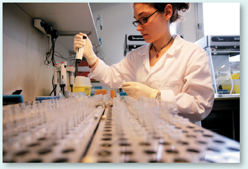14 Study Guide
 Information and Heredity
Information and Heredity
Humans have 23 pairs of chromosomes, including one pair of sex chromosomes, that follow the same patterns of Mendelian inheritance as do other organisms. Scientists study human heredity using karyotypes, pedigrees, and Punnett squares, but they also use the tools of molecular biology and bioinformatics to study DNA and gene expression. The Human Genome Project has revolutionized the study of human heredity.
14.1 Human Chromosomes
 A karyotype shows the complete diploid set of chromosomes grouped together in pairs, arranged in order of decreasing size.
A karyotype shows the complete diploid set of chromosomes grouped together in pairs, arranged in order of decreasing size.
 Human genes follow the same Mendelian patterns of inheritance as the genes of other organisms. Many human traits follow a pattern of simple dominance. The alleles for other human genes display codominant inheritance. Because the X and Y chromosomes determine sex, the genes located on them show a pattern of inheritance called sex-linkage.
Human genes follow the same Mendelian patterns of inheritance as the genes of other organisms. Many human traits follow a pattern of simple dominance. The alleles for other human genes display codominant inheritance. Because the X and Y chromosomes determine sex, the genes located on them show a pattern of inheritance called sex-linkage.
 The information gained from pedigree analysis makes it possible to determine the nature of genes and alleles associated with inherited human traits.
The information gained from pedigree analysis makes it possible to determine the nature of genes and alleles associated with inherited human traits.
14.2 Human Genetic Disorders
 Changes in a gene's DNA sequence can change proteins by altering their amino acid sequences, which may directly affect one's phenotype.
Changes in a gene's DNA sequence can change proteins by altering their amino acid sequences, which may directly affect one's phenotype.
 If nondisjunction occurs during meiosis, gametes with an abnormal number of chromosomes may result, leading to a disorder of chromosome numbers.
If nondisjunction occurs during meiosis, gametes with an abnormal number of chromosomes may result, leading to a disorder of chromosome numbers.
nondisjunction (401)

14.3 Studying the Human Genome
 By using tools that cut, separate, and then replicate DNA base by base, scientists can now read the base sequences in DNA from any cell.
By using tools that cut, separate, and then replicate DNA base by base, scientists can now read the base sequences in DNA from any cell.
 The Human Genome Project was a 13-year, international effort with the main goals of sequencing all 3 billion base pairs of human DNA and identifying all human genes.
The Human Genome Project was a 13-year, international effort with the main goals of sequencing all 3 billion base pairs of human DNA and identifying all human genes.
 The Human Genome Project pinpointed genes and associated particular sequences in those genes with numerous diseases and disorders. It also identified about three million locations where single-base DNA differences occur in humans.
The Human Genome Project pinpointed genes and associated particular sequences in those genes with numerous diseases and disorders. It also identified about three million locations where single-base DNA differences occur in humans.

Think Visually Create a concept map using the following terms: nondisjunction, autosomes, sex chromosomes, Down syndrome, Turner's syndrome, and Klinefelter's syndrome.
Table of Contents
- Formulas and Equations
- Applying Formulas and Equations
- Mean, Median, and Mode
- Estimation
- Using Measurements in Calculations
- Effects of Measurement Errors
- Accuracy
- Precision
- Comparing Accuracy and Precision
- Significant Figures
- Calculating With Significant Figures
- Scientific Notation
- Calculating With Scientific Notation
- Dimensional Analysis
- Applying Dimensional Analysis




